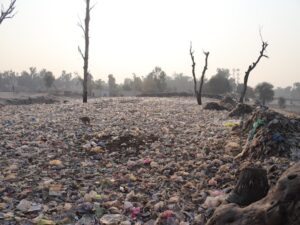Humanity collectively has its head in the sand
For a while now, there’s been a belief that sustainable development can allow three crucial prongs to be dealt with simultaneously. Reduce the worst impacts of the climate crisis, rid the world of poverty, and at the same time maintain a thriving economy. Doing so will allow us to move towards a sustainable society where human needs are met in a way that can be maintained indefinitely. That’s the idea anyway. While governments and companies continue to pioneer such an approach, emissions continue increasing, and we’re as far away as ever from ending poverty. So why is the approach failing to achieve goals? The reason is that sustainable development is a product of cognitive dissonance.
Leon Festinger coined the term cognitive dissonance in his book When Prophecy Fails. In it, he argues that when we’re faced with information that conflicts with a firmly held belief, it creates discomfort and leads to our truth defence mechanism kicking in. Rather than accept the facts, we interpret the information to make us even more convinced of our preconceived beliefs. Even when that information so obviously contradicts our beliefs.
This psychological effect is impacting our approach to sustainable development.
Take the term’s most commonly used definition. Sustainable development has come to be defined as meeting “the needs of the present without compromising the ability of future generations to meet their own needs.”
The definition is vague and open to interpretation. For starters, what exactly are the needs of the present? The definition doesn’t make that clear. Without a vision of what a sustainable society actually looks like, how can we be sure that strategies, actions and efforts are leading in the right direction? We can’t, but the term’s vagueness is why it has stuck because it’s a term that can be adapted to suit the agenda of those who embrace it.
The slipperiness of the concept is disastrous when you consider that failure to achieve sustainability isn’t an option.
On the environmental side, the International Panel on Climate Change (IPCC) has said that the global average temperature must remain below 1.5°C to avoid catastrophic changes to the climate. To achieve that goal, we must achieve net-zero by 2050.
More than 70 countries, including the biggest polluters — China, the United States, and the European Union — have set a net-zero target, covering about 76% of global emissions. Over 600 companies have signed the business ambition for 1.5°C commitment. While more than 1000 cities, over 1000 educational institutions, and over 400 financial institutions have joined the Race to Zero, pledging to take rigorous, immediate action to halve global emissions by 2030.
Fifty-one countries have gone further, enshrining a net-zero emission or “climate neutrality” goal in legislation. It sounds great until we get to the Nationally Determined Contributions (NDCs).
NDCs allow the UNFCCC to determine whether the world is on course to reach net-zero by 2050 and to reach the global peaking of greenhouse gas (GHG) emissions as soon as possible. Based on current NDCs, we’re way off the mark, with the world on track for 2.7 °C warming by 2100. And that’s a best-case scenario. The number of countries pledging to reach net-zero emissions by mid-century or soon after may be growing, but so do emissions. In 2021, global CO2 emissions reached 36.3 billion tonnes, their highest level in history.
How about the social side? Efforts to end poverty revolve around the Sustainable Development Goals (SDGs). The SDGs are a set of 17 goals agreed upon by each member of the United Nations in 2015. At the heart of the SDGs is a call for a global partnership between countries to work together to achieve the goals. The SDGs acknowledge the connection between environmental and social problems and that a sustainable world could never be sustainable if poverty remains part of it. At face value, the goals offer a powerful vision of what a sustainable world looks like should each goal be achieved.
But when you get to the nitty-gritty of the goals, you start to see problems. Goal 8 is to ‘Promote sustained, inclusive and sustainable economic growth, full and productive employment and decent work for all’, while goal 12 is to ‘Ensure sustainable consumption and production patterns’. The two goals seem to contradict one another. What does sustainable economic growth look like? And how can sustainable consumption be ensured?
Seeing as economic growth has always translated into increasing emissions and environmental destruction, and seeing as consumption is a key pillar of economic growth, it’s not entirely clear how these two key pillars of an unsustainable economy are going to be transformed to become sustainable.
Underlying the SDGs is a reluctance to question the causes of poverty and environmental destruction. So it’s no surprise that the 2022 SDG report shows we’re as far away as we’ve ever been from achieving the targets.
It appears the only prong anyone cares about is maintaining a healthy economy. And here is where cognitive dissonance comes to the fore. A healthy economy is a growing economy; a growing economy needs massive inputs of energy; that economy also needs people to buy all the stuff that is produced to enable the economy to expand. This creates more emissions, which make the climate crisis worse. Consumption is key to it all, and given that having more money and stuff than everyone else has become a key symbol of social success, it makes the idea of sustainable consumption even more abstract.
Since the 1980s, deregulation and free markets have created a world of haves and have-nots. The dominance of neoliberal ideas has been accompanied by rising inequality. Today, the richest 1% own 46% of the human wealth. Meanwhile, the richest 20% consume 80% of all resources, while the poorest 20% consume 1%. The poor don’t consume enough, while the rich consume far too much. We can’t create a sustainable society without questioning the causes of injustice and inequality and calling for measures to redistribute wealth.
The dilemma that lies at the heart of sustainable development is that developing countries are being encouraged to follow the same unsustainable development path taken by developed countries. Economic growth isn’t a problem that needs to be solved; economic growth is the solution to our problems.
This is partly true; for poverty to end, the poorest need to consume more, but if the richest keep increasing consumption habits, it will make us even more unsustainable than we already are.
The only way to overcome poverty is for the rich nations to dramatically decrease consumption habits. Seeing as consumption is the fuel that maintains economic growth, and seeing as economic growth remains the unquestioned goal of all economic activity, that is not going to happen.
We’re not moving towards a sustainable society because there is a total lack of recognition that we might have to question underlying human behaviour to get there. There seems to be a blind faith that technological innovation will somehow save the day, and we can continue living our lives as we always have. No one wants to accept that it is our lifestyles; it’s a culture of consumption; it’s economic growth; it’s free market principles; these building blocks of our civilisation are the root causes of an unsustainable society. How can we expect to move towards a sustainable society without questioning the elements of society that make it unsustainable?
That’s where cognitive dissonance rears its head. It’s blindingly obvious that without social transformation, we’re going to continue down a path that is inherently unsustainable. This is the reason greenwashing has become so rife.
Shell posted record profits of $11.5 billion for the second quarter of 2022. At the same time, they have a target to achieve net-zero by 2050. Their product is a symbol of the climate crisis, but for them to continue making record profits, they need to continue selling oil. Oil companies, as well as countless other inherently unsustainable companies, have embraced sustainable development as a smoke screen that enables them to justify those profits because they are in a state of ‘transition’.
No one wants to accept that the challenges we face are the result of systemic structural issues. Hence why our cognitive dissonance reinterprets reality to argue there’s no need to change our lifestyles, no need to make any sacrifices; all we need to do is reduce emissions by creating efficiencies. This plan hasn’t worked so far, so why is there such faith that it will work now or in the future?
We collectively have our heads in the sand because people don’t want to deal with reality. Our cognitive dissonance is shaping a suicidal strategy that is hurtling us further into a trap of our own creation. It seems the only way we will wake up from our collective cognitive dissonance is when we’re faced with crisis after crisis triggered by environmental changes. When that happens, it will be too late to do anything about it.



